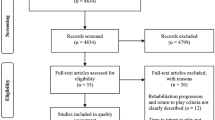Abstract
Purpose
The objective of this study was to evaluate the reproducibility of the cervical range of motion device when measuring both active and passive range of motion in a group of individuals with sub-acute Whiplash Associated Disorders (WAD).
Methods
Participants were recruited as part of a large multi-centre Randomised Controlled Trial from UK emergency departments. Experienced research physiotherapists measured active and passive cervical spine movements in all directions. Both intra- and inter-observer reliability and agreement were assessed using the intra-class correlation coefficient, standard error of measurement and limits of agreement methods.
Results
Different groups of 39 and 19 subjects were included in the intra and inter-observer studies, respectively. The CROM device demonstrated substantial intra- and inter-observer reliability and agreement for all the active and passive half-cycle movements (ICC range 0.82–0.99) with the exception of one (passive right lateral flexion for inter-observer; ICC 0.77).
Conclusions
The CROM device has proven to be a reproducible measurement method for a symptomatic WAD population using the measurement protocol described and can be used with confidence to differentiate individuals according to a single measurement.





Similar content being viewed by others
References
Maitland GD (2001) Maitland’s vertebral manipulation. Butterworth Heinemann, Oxford
Spitzer WO, Skovron ML, Salmi LR, Cassidy JD, Duranceau J, Suissa S, Zeiss E (1995) Scientific monograph of the Quebec Task Force on whiplash-associated disorders: redefining “whiplash” and its management. Spine 20:1S–73S [erratum appears in Spine 1995 Nov 1;20(21):2372]
Dall’Alba PT, Sterling MM, Treleaven JM, Edwards SL, Jull GA (2001) Cervical range of motion discriminates between asymptomatic persons and those with whiplash. Spine 26:2090–2094
Cagnie B, Cools A, De Loose V, Cambier D, Danneels L (2007) Reliability and normative database of the Zebris cervical range-of-motion system in healthy controls with preliminary validation in a group of patients with neck pain. J Manipulative Physiol Ther 30:450–455
Kasch H, Bach FW, Jensen TS (2001) Handicap after acute whiplash injury: a 1-year prospective study of risk factors. Neurology 56:1637–1643
Hartling L, Brison RJ, Ardern C, Pickett W (2001) Prognostic value of the quebec classification of whiplash-associated disorders. Spine 26:36–41
Bogduk N, Mercer S (2000) Biomechanics of the cervical spine. I: Normal kinematics. Clin Biomech (Bristol, Avon) 15:633–648
Jordan K (2000) Assessment of published reliability studies for cervical spine range-of-motion measurement tools. J Manipulative Physiol Ther 23:180–195
de Koning C, van den Heuvel S, Staal J, Smits-Engelsman B, Hendriks E (2008) Clinimetric evaluation of active range of motion measures in patients with non-specific neck pain: a systematic review. Eur Spine J 17:905–921
Williams M, McCarthy C, Chorti A, Cooke M, Gates S (2010) A systematic review of reliability and validity studies of methods for measuring active and passive cervical range of motion. J Manipulative Physiol Ther 33:138–155. doi:10.1016/j.jmpt.2009.12.009
Hole DE, Cook JM, Bolton JE (1995) Reliability and concurrent validity of two instruments for measuring cervical range of motion: effects of age and gender. Man ther 1:36–42
Tousignant M, de Bellefeuille L, O’Donoughue S, Grahovac S (2000) Criterion validity of the cervical range of motion (CROM) goniometer for cervical flexion and extension. Spine 25:324–330
Tousignant M, Duclos E, Lafleche S, Mayer A, Tousignant-Laflamme Y, Brosseau L, O’Sullivan JP (2002) Validity study for the cervical range of motion device used for lateral flexion in patients with neck pain. Spine 27:812–817
Tousignant M, Smeesters C, Breton AM, Breton E, Corriveau H (2006) Criterion validity study of the cervical range of motion (CROM) device for rotational range of motion on healthy adults. J Orthop Sports Physic Ther 36:242–248
Lamb SE, Gates S, Underwood MR, Cooke MW, Ashby D, Szczepura A, Williams MA, Williamson EM, Withers EJ, Mt Isa S, Gumber A, Team MS (2007) Managing Injuries of the Neck Trial (MINT): design of a randomised controlled trial of treatments for whiplash associated disorders. BMC Musculoskelet Disord 8:7
Bland J, Altman D (1986) Statistical methods for assessing agreement between two methods of clinical measurement. Lancet 1:307–310
Shrout PE (1998) Measurement reliability and agreement in psychiatry. Stat Methods Med Res 7:301–317
Walter SD, Eliasziw M, Donner A (1998) Sample size and optimal designs for reliability studies. Stat Med 17:101–110
Chen J, Solinger AB, Poncet JF, Lantz CA (1999) Meta-analysis of normative cervical motion. Spine 24:1571–1578
Assink N, Bergman GJ, Knoester B, Winters JC, Dijkstra PU, Postema K (2005) Interobserver reliability of neck-mobility measurement by means of the flock-of-birds electromagnetic tracking system. J Manipulative Physiol Ther 28:408–413
Youdas JW, Carey JR, Garrett TR (1991) Reliability of measurements of cervical spine range of motion—comparison of three methods. Phys Ther 71:98–104
Peolsson A, Hednlund R, Ertzgaard S, Oberg B (2000) Intra- and inter-tester reliability and range of motion of the neck. Physiother Can Summer 52:233–242
Love S, Gringmuth RH, Kazemi M, Cornacchia P, Schmolke M (1998) Interexaminer and intraexaminer reliability of cervical passive range of motion using the CROM and Cybex 320 EDI. J Can Chiropr Assoc 42:222–228
Nilsson N, Christensen HW, Hartvigsen J (1996) The interexaminer reliability of measuring passive cervical range of motion, revisited. J Manipulative Physiol Ther 19:302–305
Dvir Z, Gal-Eshel N, Shamir B, Prushansky T, Pevzner E, Peretz C (2006) Cervical motion in patients with chronic disorders of the cervical spine: a reproducibility study. Spine 31:E394–E399
Gelalis I, DeFrate L, Stafilas K, Pakos E, Kang J, Gilbertson L (2009) Three-dimensional analysis of cervical spine motion: reliability of a computer assisted magnetic tracking device compared to inclinometer. Eur Spine J 18:276–281
Acknowledgments
The authors are grateful to all the participants of the study.
Conflict of interest
None.
Author information
Authors and Affiliations
Corresponding author
Rights and permissions
About this article
Cite this article
Williams, M.A., Williamson, E., Gates, S. et al. Reproducibility of the cervical range of motion (CROM) device for individuals with sub-acute whiplash associated disorders. Eur Spine J 21, 872–878 (2012). https://doi.org/10.1007/s00586-011-2096-8
Received:
Revised:
Accepted:
Published:
Issue Date:
DOI: https://doi.org/10.1007/s00586-011-2096-8




